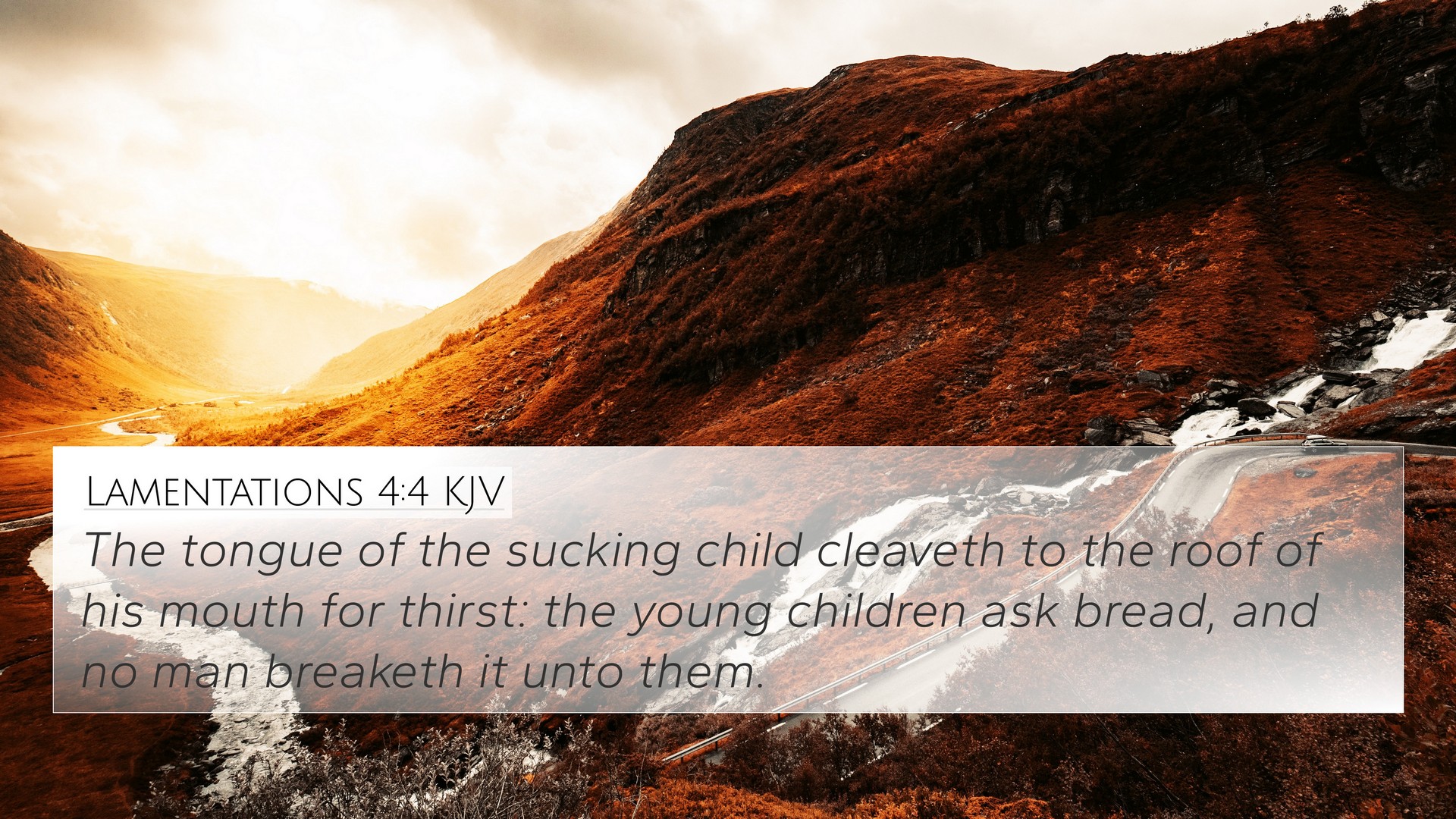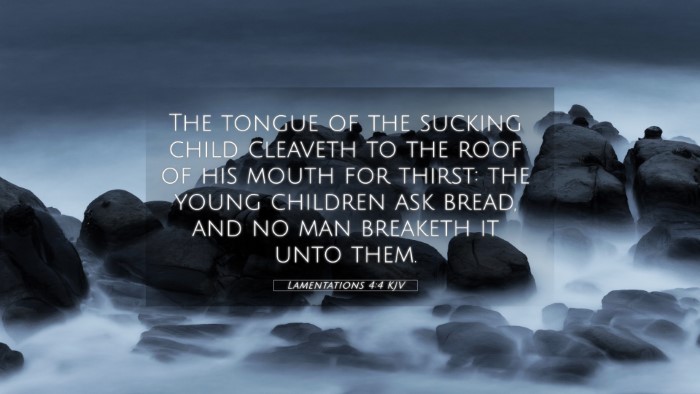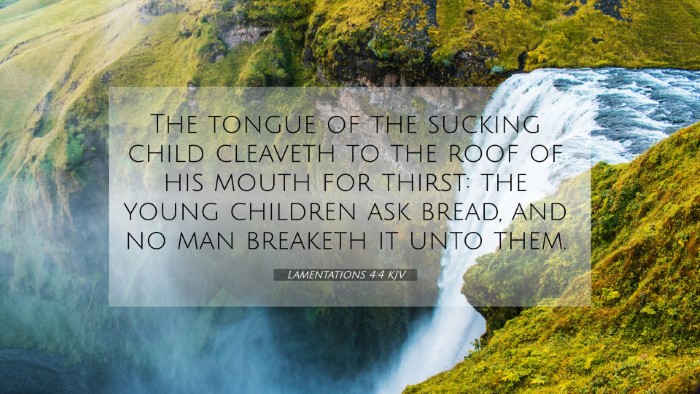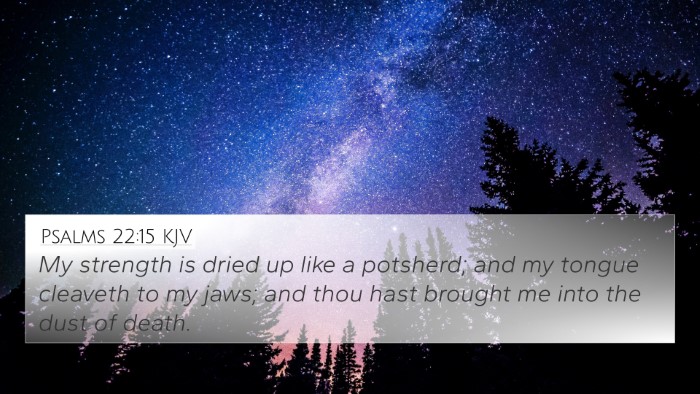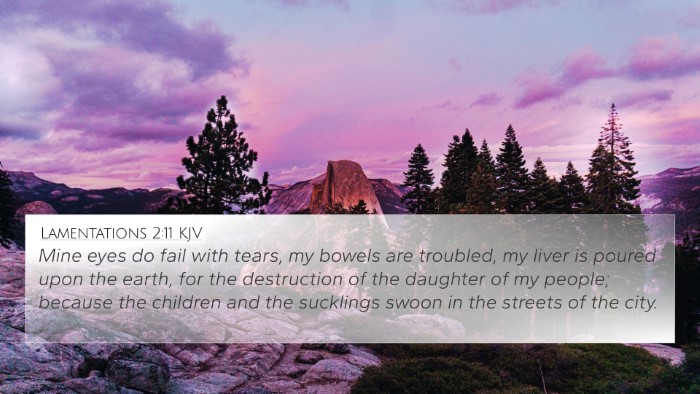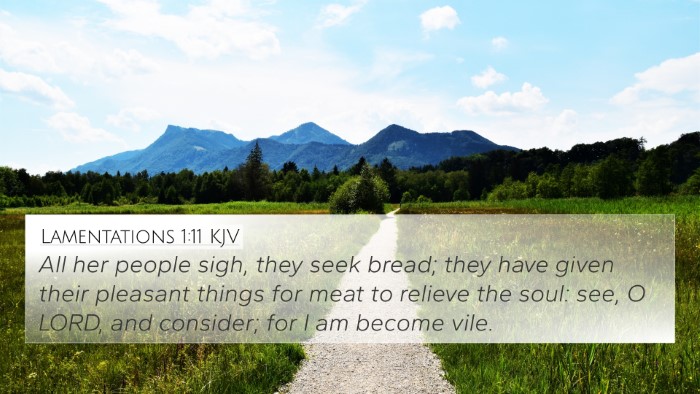Lamentations 4:4 - A Deeper Understanding
Verse: Lamentations 4:4 (KJV): "The tongue of the sucking child cleaves to the roof of his mouth for thirst: the young children ask bread, and no man breaketh it unto them."
This poignant verse from Lamentations reflects the dire straits faced by the people of Jerusalem during its siege, encapsulating the profound suffering of infants and children left in agony from hunger and thirst. To gather comprehensive insights from prominent public domain commentaries, we can draw upon the interpretations of Matthew Henry, Albert Barnes, and Adam Clarke.
Commentary Insights
Matthew Henry's Commentary
Henry notes that the verse illustrates the extreme conditions during the siege of Jerusalem where even the youngest and most helpless are suffering. The metaphor of a child's tongue cleaving to the roof of their mouth is a vivid representation of intense thirst and starvation. It signifies not just the physical hunger but also the neglect and lack of care from the surrounding community. This affliction of children symbolizes a broader spiritual desolation that has overtaken the nation.
Albert Barnes' Commentary
Barnes emphasizes the emotional agony conveyed in this verse. He views the depiction of children yearning for bread as a reflection of hopelessness in society. The lack of sustenance points to not only a physical famine but also the absence of divine assistance or human compassion. Barnes draws parallels with other instances of suffering in Scripture, indicating that this moment serves as a reminder of the consequences of national sin and the need for repentance.
Adam Clarke's Commentary
Clarke elaborates on the imagery used in Lamentations 4:4 by noting how the image of a thirsty child highlights the desperation for basic needs. He also comments on the lack of provision, stating that parents and caregivers are overwhelmed, highlighting a societal breakdown. Clarke’s analysis sheds light on the theological implications, suggesting that such suffering is interconnected with God’s judgments upon the unfaithfulness of His people.
Bible Cross-References
To enrich our understanding of Lamentations 4:4, we can identify several cross-references within Scripture that emphasize similar themes of suffering, neglect, and the plight of children:
- Psalms 102:10: Describing the complaints about the affliction and sorrow imposed upon Israel.
- Isaiah 3:4: Discussing the consequences of straying from God, leading to the figure of children ruling over the people.
- Jeremiah 14:3-4: Highlighting famine and drought affecting the inhabitants, paralleling the lack of bread in Lamentations.
- Matthew 21:16: Jesus quoting children praising Him, showcasing innocence amidst suffering.
- Isaiah 49:15: God’s promise not to forget His children, even amidst dire circumstances.
- Luke 11:11: Jesus teaching about giving good gifts, contrasting the human condition described in Lamentations.
- James 1:27: True religion as caring for orphans and widows, echoing the neglect of children in Lamentations.
- 2 Corinthians 1:4: God comforts us in all troubles, linking it to the hope amidst suffering.
- Matthew 2:18: The mourning for children during Herod’s massacre parallels the grief expressed in Lamentations.
- Revelation 21:4: A promise of future restoration where suffering, including that of children, will be no more.
Thematic Connections
The themes explored in Lamentations 4:4 resonate with several motifs throughout the Bible that include:
- The suffering of innocents: Reflects God's compassion and the call for justice.
- God’s judgment: Often depicted through the plight of the vulnerable and marginalized, reminding believers of the consequences of disobedience.
- Hope amidst despair: Links to various prophetic declarations and messianic promises assuring restoration.
Conclusion
Lamentations 4:4 serves as a sorrowful reminder of the consequences of sin and societal breakdown, especially as it pertains to the most vulnerable members of society. By exploring Matthew Henry, Albert Barnes, and Adam Clarke’s commentaries, we gain insights into not only the textual meaning but also the broader theological implications. Cross-referencing this verse with others creates a richer tapestry of understanding, allowing deeper connections between biblical truths and themes prevalent throughout scripture.
